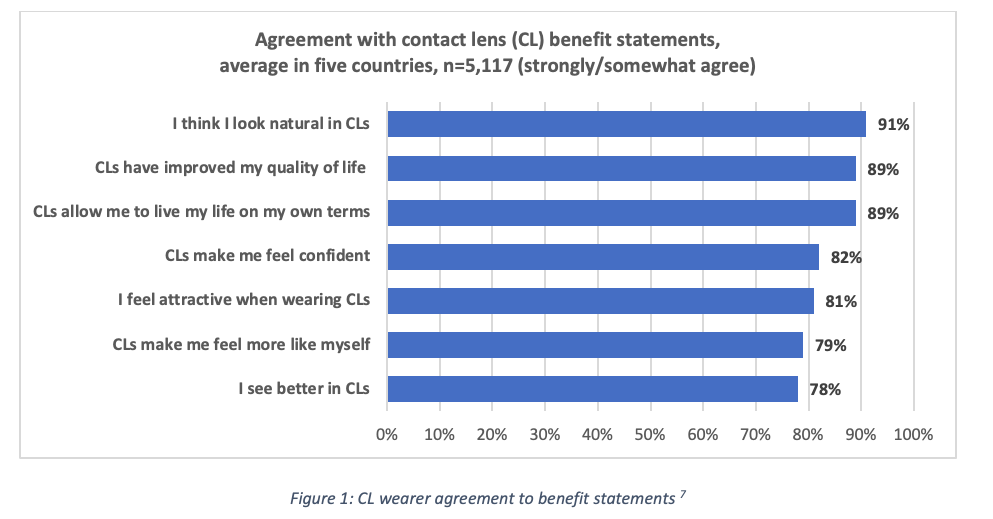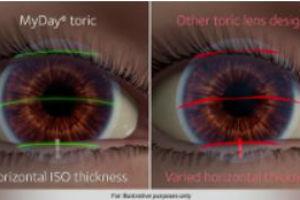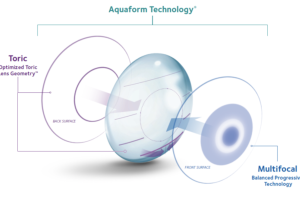
The majority of people who require vision correction are spectacle-only wearers. Best estimates suggest in the US, just over one-quarter of these are dual wearers (27%), choosing to correct their vision with both spectacles and contact lenses (CLs).1 Contemporary contact lenses are available in a wide selection of materials, modalities, prescription ranges and designs, with the result that many more people could be fit. While it is widely recognized proactive recommendation of contact lenses increases the number of new wearers,2-4 how can the eye care practitioner (ECP) personalize their advice to make it as compelling as possible?
Common reasons for starting to wear contact lenses include being troubled by the inconvenience of spectacles when exercising or playing sports, or because the person does not like the way they look in glasses.5 While these reasons are important to mention to patients when recommending contact lenses, additional knowledge on the deeper benefits gained when they are worn can help eye care practitioners (ECPs) and their staff broaden the conversation.
The experience of contact lenses wearers has been gathered from a number of markets around the world, providing insights to the deeper emotional benefits they experience. In a survey conducted in the UK, when wearing a visual correction for the first time, at least 2.5 times more lens wearers reported positive feelings such as experiencing freedom, feeling confident and happy compared to spectacle only wearers.6 Compared to spectacle wearers, significantly more contact lens wearers also reported benefits of “freedom without restrictions”, improved experiences when “meeting friends” and increased self-confidence when wearing their lenses.6 Deeper emotional benefits were also signaled with significantly more contact lens wearers stating they loved their correction and that it had transformed their life.6
These benefits were echoed in the response from more than five thousand contact lenses surveyed in Germany, Great Britain, Japan, Spain and the United States.7 Nearly nine out of ten (89%) agreed that contact lenses had “improved their quality of life” and “allow them to live their life on their own terms”.7 The highest level of agreement was to the statement “I think I look natural” (91%), with around eight out of ten wearers also agreeing they “feel attractive” and “more like myself” in contact lenses (Figure 1).

The visual benefits of contact lenses were also recognized with nearly eight out of ten contact lens wearers agreeing with the statement “I see better in CLs”. This high level of agreement for seeing better in contact lenses held true even for the presbyopic group aged 55 and over. In fact, contact lens wearers have high expectations of their ECP when it comes to vision. Regardless of cost, 86% agreed they expect their ECP to make a recommendation for the soft CLs that provide the best possible vision correction for their eyes.7 This means ECPs can make the most suitable recommendation for their patient’s prescription, for example toric or multifocal lenses, confident in the knowledge that most patients want to be informed of all their options.
To make use of these insights in practice, it is helpful to bear in mind the deeper positive emotional benefits patients can experience from wearing contact lenses. While for many the motivation may be practical, helping with sports for example, it is important to remember that contact lenses make people feel differently – they feel more natural or more like themselves. It may not always be easy to explain this to a patient up front, but what ECPs can do is recommend contact lens on-eye experiences to enable patients to gauge for themselves not only how they look and see in contact lenses, but how they feel too.
References
1. CVI data on file 2019. Industry and Market data, US consumer CL market in 2018.
2. Jones L, Jones D, Langley C, et al. Reactive or proactive contact lens fitting - does it make a difference? J Brit Contact Lens Assoc 1996;19:41-3.
3. Meyler J. STAR performers. Optician 1996;212:18-9.
4. Morgan S, Efron N. The benefits of a proactive approach to contact lens fitting. J BCLA 1996;19:97-101.
5. CVI data on file 2020. YouGov online survey. Total sample size was 8,203 adults aged 18+ in US, Japan, Great Britain, Italy, Sweden, Canada, The Netherlands and Australia who either wear glasses only (n=4,139) or wear both glasses and contact lenses (n=4,064). Fieldwork was undertaken between 12th - 28th October 2020.
6. Draper M, Patel K, Russell N. Mixed-methods study of behaviours and attitudes to vision correction of spectacle and contact lens wearers. Contact Lens and Anterior Eye 2019;42:e23.
7. CVI data on file 2020. YouGov online consumer survey Nov/Dec 2019 in Germany, UK, Spain, Japan, USA. N=5,347 contact lens wearers ('consumers'), screened from total N=35.397 adults. Data weighted and representative of adults in each market (aged 18+).








